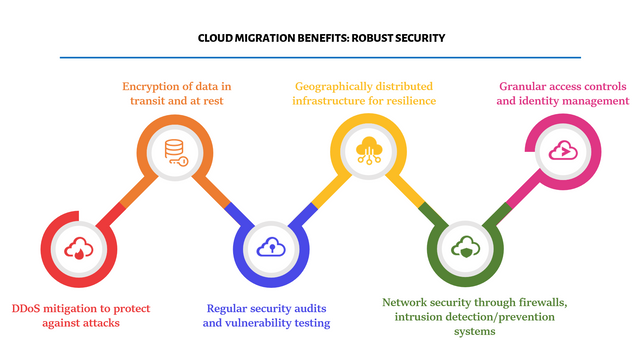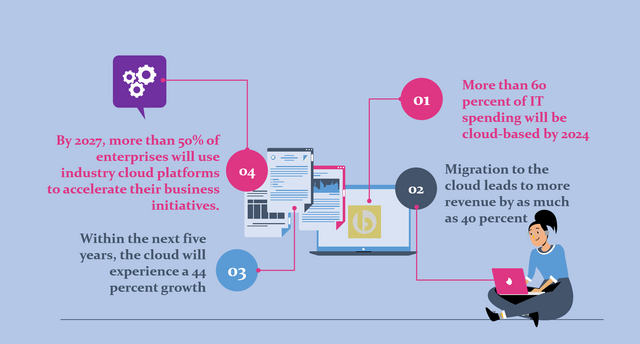Benefits of Cloud Migration Strategy: A Complete Guide
Cloud migration strategy refers to an organization's plan, processes, and procedures to move its data, applications, infrastructure, and workloads from on-premise environments to the cloud. A sound cloud migration strategy is crucial for realizing the full benefits of cloud migration strategy and the return on investment of migrating to the cloud.
A result-oriented approach ensures that the migration strategy aligns with clear business objectives. The strategy should focus on measurable outcomes like reduced costs, increased efficiencies, faster innovation, and improved scalability. A strong strategy brings structure, guidance, and governance throughout the transition to minimize disruptions.
Cost Optimization
Migrating to the cloud can lead to significant cost savings and organizational optimization. By utilizing cloud infrastructure and platforms, companies can reduce their capital expenditures and move to an operating expenditure model.Reduced Infrastructure Costs
With cloud migration, businesses no longer need to invest heavily in purchasing and maintaining their own on-premises hardware and data centers. The cloud provider manages the infrastructure, so upfront costs are substantially reduced. Organizations only pay for computing, storage, and services they use. This utility-based model allows for more predictable costs and avoids over-provisioning resources.Pay-as-You-Go
The pay-as-you-go nature of the cloud allows usage and costs to be aligned. Companies can scale services up or down to match demands, so they do not have to depend on the limitations of fixed on-premises infrastructure. The Opex model provides agility and flexibility and helps optimize spending. Businesses are using their money wisely to maintain unused capacity.Resource Consolidation Benefits
Migrating to the cloud encourages consolidation of resources and applications. Rather than siloed on-premise infrastructure, companies can right-size and utilize shared resources efficiently. Consolidation drives higher utilization rates and reduces costs per workload. Less hardware must be purchased, powered, cooled, and managed when resources are consolidated thoughtfully in the cloud.Scalability and Flexibility
One of the significant benefits of cloud migration strategy is its scalability and flexibility. Cloud computing makes it easy to scale resources up or down to meet changing demands.Elasticity of Cloud Resources
Cloud platforms allow for rapid provisioning and release of resources to match workload requirements. If your needs increase due to a surge in traffic or the growth of your business, you can quickly scale up your cloud resources like storage, computing power, and memory. When needs decrease again, you can scale back down just as quickly - the best way to achieve cloud resource management. This elasticity ensures you only pay for the resources you need at any given time.Easy Scalability for Growing Demands
With traditional on-premises infrastructure, scaling can be complex and requires forecasting long-term hardware needs. With the cloud, you can dynamically scale to accommodate spikes or growth in demand. The flexibility of the cloud allows you to expand capabilities and scale resources out linearly quickly. Automated scaling tools even allow scaling in response to metrics like CPU usage. It makes sure applications can handle increasing workloads seamlessly.Adaptability to Changing Business Needs
The scalability of the cloud also enables adapting your infrastructure to changing business needs in an agile way. You can test new ideas, launch new initiatives, and expand to new markets quickly. The cloud allows enterprises to be nimbler and react faster to opportunities and competitive threats. Even startups can leverage the cloud to get off the ground quickly while keeping costs variable—the scalability and flexibility of the cloud future-proof companies of all sizes against business and technology shifts.Improved Performance
Migrating to the cloud can significantly improve application and system performance in several key ways:Enhanced Speed and Efficiency
Cloud infrastructure utilizes high-speed networks, efficient load balancing, and distributed computing power to boost performance. It enables rapid provisioning of resources to meet rising demand and workload requirements. You enjoy reduced latency by hosting data in multiple geographic regions closer to users. Cloud platforms are optimized for speed, agility, and high performance.
.Cloud-based apps and services also avoid the performance bottlenecks of on-premise systems. There is no need to purchase and configure expensive new hardware, which can take weeks or months. Instead, with a few clicks, you can deploy cloud resources instantly. It allows businesses to maintain consistently high performance.
Optimized Workload Distribution
The cloud provides intelligent workload distribution and horizontal scaling of app instances. Additional resources are allocated automatically during traffic spikes to ensure smooth performance. If traffic drops, resources can downscale to save costs. Cloud service providers utilize load-balancing algorithms to monitor traffic and optimize routing in real-time. It prevents uneven loads on servers and keeps apps running fast. Geographic distribution of workloads also reduces latency.Impact on User Experience
Cloud migration leads to faster page load times, data processing, and file transfers by eliminating performance bottlenecks. Apps and websites stay highly responsive even during traffic peaks.
For employees, optimized cloud performance means faster access to data and workflows. For customers, it translates into much-improved user experiences, higher satisfaction, and increased engagement across the web and mobile apps.
Moving to the cloud has a profoundly positive impact on application performance and end-user experiences. It enables businesses to deliver consistent and reliable high-speed services.
Enhanced Security
Moving to the cloud enables organizations to leverage robust and enterprise-grade security measures offered by cloud providers. Cloud platforms invest heavily in cutting-edge security technologies and employ dedicated experts to implement industry best practices.
Robust Cloud Security Measures
Cloud providers offer a wide array of built-in security controls that organizations can take advantage of. These include:
- Encryption of data in transit and at rest
- Network security through firewalls, intrusion detection/prevention systems
- Regular security audits and vulnerability testing
- Granular access controls and identity management
- DDoS mitigation to protect against attacks
- Geographically distributed infrastructure for resilience
Compliance and Data Protection
Cloud platforms provide compliance certifications (e.g., SOC 2, ISO 27001, PCI DSS, HIPAA) and undergo rigorous third-party audits to adhere to strict industry standards. It makes it easier for organizations to comply with regulations. Data protection is enhanced through redundancy across multiple data centers, robust backup systems, and disaster recovery mechanisms. Cloud providers also enable fine-grained access controls to data.Role of Cloud Service Providers
A key benefit is that security management and responsibility are shared with the cloud provider. Organizations can leverage the cloud provider's expertise, resources, and dedicated security teams to strengthen their security posture.
The cloud provider actively secures the underlying infrastructure and keeps up with evolving threats. Organizations can focus on securing their applications and data while relying on the cloud provider's robust physical and network security.
It allows organizations to improve security cost-effectively without needing large in-house security teams. The scalability of cloud platforms also enables security measures to handle large traffic volumes and DDoS attacks.
Business Continuity and Disaster Recovery
Moving to the cloud can significantly improve an organization's ability to maintain business continuity and quickly recover from potential disasters. Some key benefits of cloud migration strategy in this area include:Redundancy and Data Backups
The cloud provides built-in redundancy to ensure applications and data remain highly available. Cloud providers rely on redundant servers across multiple data centers to guard against localized outages. Data is also regularly backed up in distributed and secure cloud storage. These measures allow operations to continue uninterrupted even if a data center goes down.Quick Disaster Recovery
The cloud allows faster recovery times in a disaster than traditional on-premises infrastructure. Cloud providers have sophisticated data replication and automated failover capabilities, enabling critical systems to be returned online within minutes or hours. Organizations can restore from cloud-based backups versus re-provisioning their own damaged servers.Minimizing Downtime Impact
Leveraging the cloud's redundant infrastructure and rapid recovery strategies can significantly reduce potential disaster downtime. For mission-critical applications, multi-region deployments and load balancing further minimize the impact users may experience. With proactive measures and cloud-based recovery, organizations can aim for near-zero downtime and continuous availability.
A cloud migration strategy makes enterprises better equipped to handle disasters and keep business-critical functions online. Built-in redundancies and accelerated recovery translates to less disruption, even in worst-case scenarios.
Collaboration and Remote Work
Moving to the cloud facilitates remote work and collaboration across distributed teams like never before. Employees can securely access company data and applications from anywhere with an internet connection using cloud-based tools and platforms. It enables organizations to support remote employees and efficiently work flexibly from multiple locations.Facilitating Remote Work
The cloud provides the technology backbone to enable remote work at scale. Workers can use cloud-based software, communication platforms, productivity tools, and more from home just as quickly as they can from a central office. Cloud servers allow remote employees to access centralized data and applications securely. Organizations can provide best-in-class cloud technology to all employees, regardless of location.Collaboration Tools in the Cloud
Built-in collaboration tools within cloud platforms streamline communication, file sharing, task management, and more for distributed teams. Famous examples include cloud storage like Dropbox, project management systems like Asana, communication tools like Slack, and document creation suites like Google Docs. These solutions enable seamless collaboration in real-time across any number of remote workers.Flexibility for Distributed Teams
With a cloud-based infrastructure, organizations can implement flexible work policies and support employees across multiple geographic locations. Physical offices no longer limit hiring, allowing the forming of teams regardless of team members' area. The cloud provides the connectivity for distributed teams to work cohesively and collaborate as if they were in the same room. This level of flexibility is difficult and expensive to achieve using traditional on-premises IT systems.Innovation and Future-Proofing
Adopting a cloud migration strategy allows organizations to utilize cutting-edge technologies and position themselves for future growth. The cloud enables access to innovative capabilities that would be costly and complex to implement on-premises.
Access to Cutting-Edge Technologies
The major cloud providers continuously invest in emerging technologies and make them available to customers. For example, organizations can leverage artificial intelligence, machine learning, blockchain, edge computing, and more through cloud services. Rather than building these from scratch, companies can quickly incorporate innovative capabilities into their operations.
Continuous Updates and Improvements
With cloud computing, providers manage the underlying infrastructure and roll out continuous updates in the background. Organizations benefit from new features and security patches without any action needed. The cloud offers a constantly evolving platform, so businesses can focus on higher-value tasks.
Staying Ahead in the Digital Landscape
Companies must keep pace with technology shifts and evolving customer expectations to remain competitive. Migrating to the cloud allows one to modernize systems, gain agility, and better prepare for emerging trends. With the right strategy, cloud adoption can help future-proof the business to thrive in the digital landscape. The cloud allows organizations to leverage next-generation technologies today and take a proactive approach to innovation.
Streamlined IT Management
Migrating to the cloud can significantly streamline IT management for organizations. Some of the key benefits of cloud migration strategy in this area include:
Centralized Management Dashboard
With cloud infrastructure, businesses can implement a centralized management dashboard that provides a unified view and control over the entire IT environment. Rather than managing servers, software, and services across disparate on-premises systems, everything is managed through a single pane of glass.
Cloud providers offer management consoles that allow IT teams to monitor resources easily, check system health metrics, track usage and spending, adjust configurations, automate tasks, and more. It dramatically simplifies management and reduces administrative overhead.
Automated Updates and Patching
Managing infrastructure updates and security patching in an on-premises environment can be tedious and time-consuming. You can automate these critical tasks across the technology stack with the cloud.
Cloud providers handle backend infrastructure updates and maintenance without any effort required by customers. Platforms and software services in the cloud are also continuously updated, patched, and secured by the provider.
IT teams are freed from constant update cycles and can rely on the cloud provider to automate this critical work across the entire environment.
Resource Monitoring and Allocation
Cloud Computing offers the flexibility to quickly spin resources like servers, storage, and networking up and down through software. It enables dynamic right-sizing as demands change.
Cloud management tools provide real-time visibility into resource utilization for proactive optimization. Usage metrics help identify waste and increase efficiency. IT staff can monitor performance and allocate resources to meet business needs and priorities.
Cloud migration enables organizations to "pay for what they use" and reduce resource overprovisioning by simplifying resource allocation and eliminating guesswork. IT staff is empowered to respond and adjust quickly as business conditions evolve.
Successful Implementations
Cloud migration can lead to dramatic improvements for businesses when implemented successfully. One example is the multinational conglomerate Unilever, which adopted a cloud-first strategy and migrated 700 servers, 800 TB of data, and over 1,000 applications to the cloud. It resulted in a 30-40% reduction in infrastructure costs and much faster deployment of new capabilities. Unilever completed core workload migration in just ten months, enabling greater agility.
Another positive case study is the cloud migration of media company Lionsgate. By moving to the cloud, Lionsgate achieved a global availability of content, flexible scaling to meet demands, and reduced time to market for new applications from 6 months to just six weeks. The company also saved $4 million in annual IT infrastructure costs.Business Transformations
Migrating to the cloud can allow businesses to completely transform their operations, products, services, and business models. One example is General Electric. GE leveraged the cloud to gather and analyze data from industrial machines and gain insights to improve efficiency, production, and maintenance. This transformation enabled new service offerings and revenue streams for GE.
For Finnish telecom company Elisa, a cloud migration drove a 30% improvement in time-to-market, a 50% boost in productivity, and the ability to quadruple compute capacity in only 20 minutes. This agility allowed Elisa to deliver innovative 5G services ahead of competitors.
Lessons Learned
Critical lessons from successful cloud migrations include the need for detailed planning, stakeholder buy-in, strong project management, user training, and post-migration optimization. Many companies need to pay more attention to migration complexity. They should allow sufficient time for execution and focus on driving business value vs. just cost savings. Testing workloads at scale and having rollback plans are also critical.
Companies should also choose cloud platforms strategically based on business needs and avoid lock-in. Using cloud-native services and re-architecting legacy apps for the cloud allows businesses to benefit fully from cloud advantages. With the right strategy and planning, companies can leverage the cloud to transform digitally.
If you want to work on a scalable cloud migration strategy and adopt the cloud seamlessly, you can partner with a reliable company offering cloud migration services.


